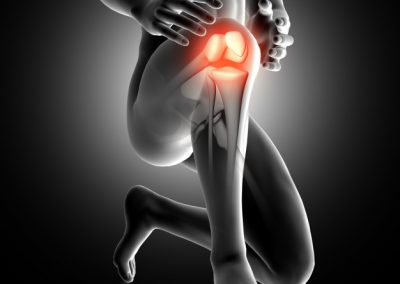
Conditions
Knee Arthritis
Also known as wear-and-tear arthritis, is a condition affecting the natural cushioning, or cartilage, between joints in the knee.
Schedule an AppointmentKnee Arthritis Facts and Information
Knee arthritis is a gradual breakdown of cartilage in the knee joints. Cartilage is a tough, flexible connective tissue that protects the ends of bones in the joints. Osteoarthritis is common in the knee because the knee bears the weight of the body. Osteoarthritis of the knee can severely impact a person’s lifestyle.
Knee Arthritis Symptoms
Symptoms of osteoarthritis of the knee may include knee. Movement may increase this pain. The knee may feel tender when pressure is applied. The person may experience a grating sensation when walking. The knee may feel stiff, and this stiffness may interfere with the leg’s range of motion.
Causes of Knee Arthritis
Knee arthritis commonly develops as a result of the wear and tear of aging. It also frequently results from traumatic injury to the joint. Osteoarthritis of the knee is more common in older people, in women, and in people who have occupations that place increased stress on the knee. People who have certain diseases, bone deformities or a genetic predisposition are also at a higher risk. Obesity can also raise a person’s risk for osteoarthritis of the knee, because extra body weight increases stress on the knee joint.
Progression
In a healthy knee, the ends of the bones are covered by a layer of cartilage. Healthy cartilage allows the bones to glide smoothly against each other. But in a knee with osteoarthritis, this cartilage begins to deteriorate and wear away. Repetitive motion or injury may speed this deterioration. Eventually, the bones may rub directly against each other.
Bone Spur Formation
This rubbing can cause the gradual growth of bony bumps along the edge of the joint. These lumps, called bone spurs (or osteophytes), can cause joint pain.
Diagnosis
- Thorough clinical evaluation. Complete medical history, analysis of your symptoms, and physical examination.
- Testing may include x-rays, MRI and/or CT scans, and electro-diagnosis (EMG). These advanced diagnostic techniques definitively pinpoint the source of pain.
Knee Arthritis Treatment
- Nerve Root Block
- Platelet Rich Plasma (PRP)
- Spinal Cord Stimulator (SCS)
- Stem Cell Therapy
- Radiofrequency Ablation
Disclaimer: the content of the Website is for general informational purposes only and does not constitute advice of any kind. See the full User Agreement here.

Take Back Your Life
Fill out the form or simply give us a call to book your appointment and start feeling better.

Contact Us
Speak with one of our team members right away to get answers to your questions about insurance verification, scheduling an appointment, and our clinic locations.
(732) 955-0655Visiting our Book Appointment page you can instantly request an appointment at any of our Seacoast Spine and Sports Medicine. We offer Free Insurance Verification before your appointment.
Learn how to easily get to the Seacoast Spine and Sports Medicine.
